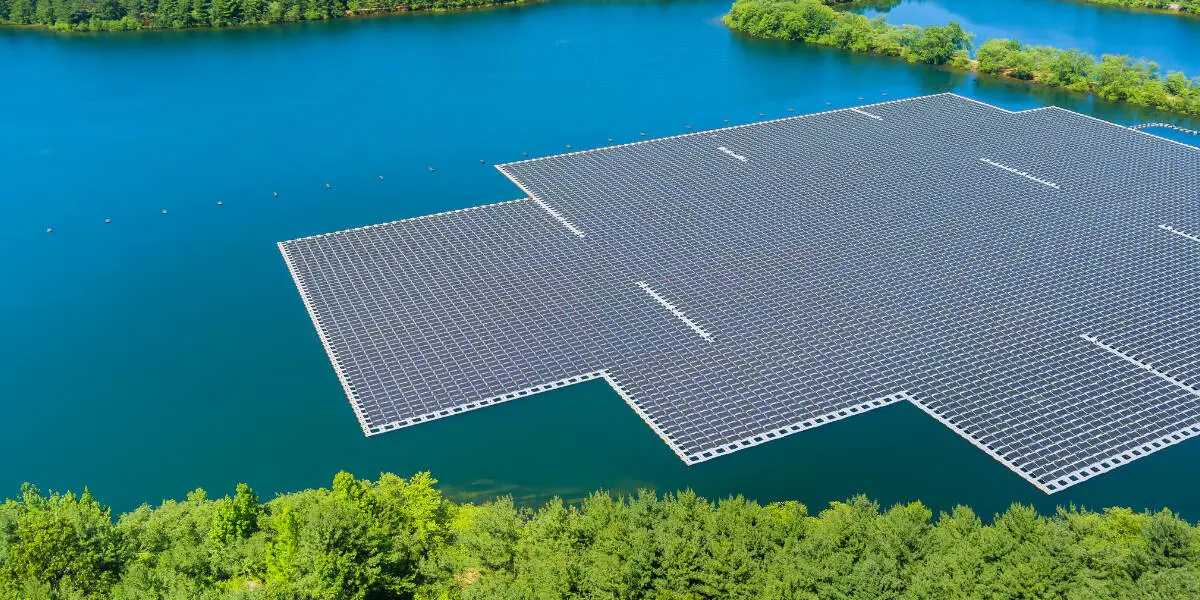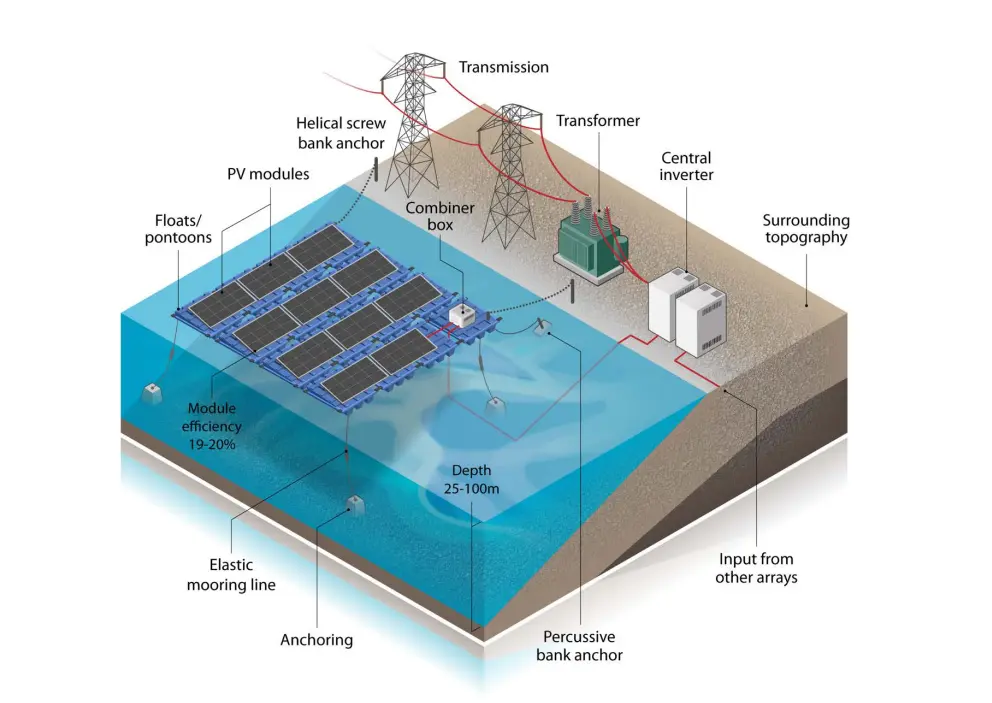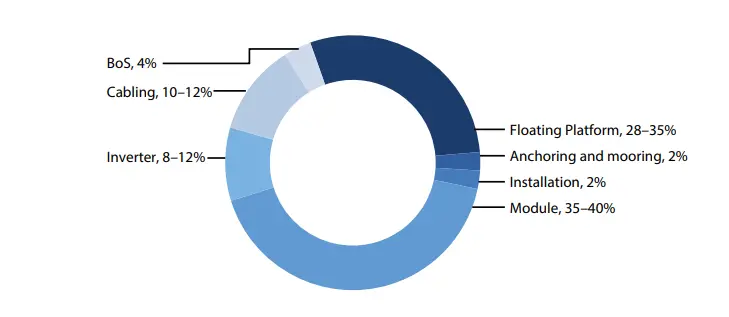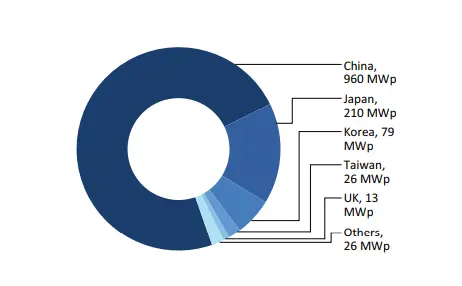Table of Contents
Floating photovoltaic power plants are solar panels on water bodies that generate power by converting solar energy into electricity. Initially, the solar energy is harvested in small quantities for domestic purposes. However, the cost-effectiveness of the solar power plants helped the growth exponentially into an industrial level.
Common ground-mounted solar power plants use excessive land resources. The traditional approach of installing large-scale, ground-mounted solar power plants across vast expanses of land presents a challenge. An alternative solution lies in utilizing large water bodies for these installations.
An interesting fact is that the global capacity of floating solar power has grown a hundred times from 2014 to 2018. With a total installed capacity of 10 GW, floating photovoltaic power plants will soon overtake ground-mounted solar energy.
India's largest floating solar power plant, based on generation capacity, is located in Ramagundam, Telangana, with a capacity of 100 megawatts (MW). The cost of a 1 MW floating solar power plant in India can vary depending on factors like project size, location, and technology used.
In 2007, the National Institute of Advanced Industrial Science and Technology (AIST) built the world's first floating solar photovoltaic plant with a 20-kWp capacity in Aichi, Japan. Currently, China is leading the floating solar power plant market, followed by Japan and India. Let’s explore floating solar power plants, how they work, and their advantages.
What are Floating Solar Power Plants?

Floating solar power plants, also known as floatovoltaics, are an innovative way to generate clean energy by utilizing solar panels mounted on structures that float on top of bodies of water. These water bodies can be reservoirs, lakes, canals, or even man-made ponds.
Following the success of the first experimental floating solar power station, commercial megawatt-scale projects were deployed in Japan and South Korea by 2013. These advancements led to a significant global expansion of floating solar power plants. By the end of 2018, total global solar capacity had achieved a remarkable 1300 Megawatt-peak (MWp).
Find Solar Photovoltaic Project and Tender Leads around the GlobeClaim Your Free Leads!
Components of Floating Photovoltaic Power Plants

Source: nrel.gov
Floating Solar Farms share many similarities with traditional solar panels but require special adaptations to function on water. Here's a breakdown of the key components:
Floating Photovoltaic Panels
The core electricity generators use floating solar panels similar to those found in land-based systems. These can be polycrystalline, monocrystalline, or thin-film technologies, chosen based on factors like space constraints, cost, humidity levels, and the specific water body. Selection criteria include factors like power output, efficiency, and how they perform in high moisture and humidity conditions.
Inverters
Floating photovoltaic systems convert the DC electricity generated by the PV panels into AC electricity suitable for the power grid. Inverters can be string inverters or central inverters, chosen based on project scale and distance from the shore. For smaller plants, inverters may be located on land near the panels, while larger installations might house them on a separate floating platform.
Floating Platform
This floating structure supports all the necessary equipment, including the photovoltaic panels, inverters, and combiner boxes. High-density polyethylene (HDPE) is the most common material due to its affordability and durability. Other options include FRP, medium-density polyethylene (MDPE), and ferro-cement. The platform design must account for potential water level variations caused by seasonal changes.
Floating Solar Mooring System
Since Floating Solar Photovoltaic plants operate on water bodies, they require anchoring to prevent drifting due to wind, currents, or wave action. The floating solar mooring system design considers factors like location, water depth, bottom conditions, and water level fluctuations. It typically consists of anchors (concrete blocks or other types), mooring lines (nylon polyester or nylon nautical ropes), and attachment points on shore (bollards). There are three main mooring configurations:
- Bank Anchoring: Suitable for shallow, small water bodies where bottom anchoring isn't feasible. It's cost-effective but visually impactful due to its visibility from land.
- Bottom Anchoring: The most popular option is anchoring, which is either directly inserted into the water body bottom or connected through concrete blocks placed at the bottom. Mooring cables and chains then connect the anchors to the floating platform.
- Piles: Piles are drilled into the waterbody bottom, and the platform is moored to them. This method is best for handling water level variations but is expensive due to the need for heavy equipment and civil work.
Cabling
Unlike land-based solar farms, Floating Solar arrays require careful planning for cable routing and management due to the movement of the floating platform on the water's surface. Wind load and water level variations can cause the platform to shift, necessitating extra slack in the cables to prevent them from snapping due to tension.
Several factors influence cable size selection:
- Cable Length: As mentioned earlier, the dynamic nature of the floating platform requires additional cable length compared to land-based systems. This slack accommodates platform movement without stressing the cables.
- Voltage and Current: The voltage and current carried by the cable determine its size and capacity requirements.
- Cable Losses: Energy losses that occur during transmission through the cables need to be factored in when choosing cable size.
Read: Top Ten Photovoltaic Power Stations in the World
How Floating Photovoltaic Power Plants Work?
Floating solar power plants, similar to their land-based counterparts, capture the sun's rays and convert them into electricity. However, they offer a distinct advantage: cooler water temperatures.
Here's a breakdown of the basic workings of a floating photovoltaic power plant:
- Sunlight Capture: Just like land-based solar farms, floating plants utilize solar panels to capture sunlight. These panels are typically made of silicon cells that convert photons (light particles) into direct current (DC) electricity through the photovoltaic effect.
- Power Conversion: The DC electricity generated by the solar panels needs to be converted into alternating current (AC) for use in the power grid. This conversion is done by inverters, which are electronic devices that transform the DC into AC. The inverters utilize power electronics like transistors and capacitors to achieve this transformation.
- Voltage Adjustment: In some cases, transformers may also be used within the floating solar plant. Transformers can adjust the voltage of the electricity produced. This can help reduce electrical losses during transmission over long distances.
- Energy Transmission: The AC electricity generated by the floating solar plant needs to be transmitted to the shore for connection to the power grid. Underwater cables are used for this purpose. These cables are specially designed to withstand extended immersion in water and must meet anti-corrosion standards.
Cost of Floating Solar Power Plant

Source: teriin.org
Setting up a floating solar power plant comes at a higher cost compared to traditional land-based solar farms. A significant portion of this difference can be attributed to the floating structures and anchoring systems required to keep the panels afloat and secure on the water. Estimates suggest the cost of floaters alone can account for nearly half of the total project cost for a floating solar plant.
Currently, installing a 1 MW floating solar project can range from USD 630,000 to USD 765,500, which is considerably higher than the USD 5,100 to USD 6,500 needed for a land-based project of the same capacity. While floating solar power plants are currently more expensive, experts predict this gap will close soon. Advancements in technology and more affordable components will make floating solar a more cost-effective option in the future.
Advantages of Floating Solar Power Plants
| Advantage | Description | Benefit |
| Space Efficiency | Utilizes underused water bodies (reservoirs, lakes, dams) | Saves valuable land for agriculture or development |
| Enhanced Efficiency | Cooler water temperatures due to water water-cooling effect | Up to 15% increase in solar panel efficiency, generating more electricity |
| Albedo Effect | Sunlight reflects off water's surface onto solar panels | Increases the amount of sunlight captured, boosting energy output |
| Water Conservation | Reduces water evaporation from reservoirs (especially in arid regions) | Preserves vital water resources |
| Reduced Algae Growth | Limits sunlight penetration, controlling harmful algae growth | Improves water quality and protects aquatic ecosystems |
| Reduced Installation Costs | No land acquisition or extensive site preparation is needed | Potentially lower upfront costs compared to land-based systems |
| Low Impact on Aquatic Life | Careful design minimizes disruption to aquatic habitats | Promotes coexistence with the aquatic ecosystem |
| Enhanced Security and Durability | Location on water bodies reduces accessibility | Less risk of vandalism or theft; potentially longer lifespan due to less wear and tear |
Global Floating Solar Power Market

Source: teriin.org
The Floating Solar Photovoltaic sector is experiencing a surge in popularity, but government support and specific policies are still limited. While there are no universally applied standards or regulations for Floating Solar Photovoltaic technology, a few Asian countries are leading the way.
- Early Adopters: Japan, Malaysia, and Vietnam have implemented preferential feed-in tariffs (FiTs) specifically for Floating Solar Photovoltaic projects. These initial projects have typically been small-scale (under 5 MW) and financed by local banks using local currencies.
- Shifting Trends: Large international commercial banks and multilateral development banks are interested in financing Floating Solar Photovoltaic projects. This trend is expected to lead to the development of large-scale installations.
- Policy Drivers: Government initiatives, such as Renewable Energy (RE) targets, are propelling Floating Solar Photovoltaic development in some countries like China, Japan, Korea, and India. Here, tenders and auctions are the primary methods used for implementing larger Floating Solar Photovoltaic projects (greater than 2-5 MW).
Read: Top 10 Largest Solar Farms in India [2023]
Global Leaders in Floating Solar Photovoltaic
China
The undisputed leader in Floating Solar installation, China boasts 73% of global installations. Most of these large-scale projects (over 5 MW) are built on flooded mines and developed under the country's Top Runner Programme, which aims for a significant increase in solar PV installations by 2020.
Japan
Following China with 16% of global installations, Japan was the first country to launch a floating solar pilot project (20 kWp) in 2007. While FiTs were initially used for most solar projects in Japan, competitive bidding processes now determine electricity tariffs for larger projects (over 22 MWp).
Taiwan, China
Ranking fourth globally with over 26 MWp of installed capacity and another 180 MWp in development, Taiwan, China is one of the few countries offering specific FiTs for Floating Solar Photovoltaic projects. These FiTs are about 10% higher than those for land-based solar PV systems of similar size.
The Republic of Korea
With an ambitious target of 30.8 GW of solar energy by 2030, South Korea is actively promoting renewable energy. They replaced FiTs with a Renewable Portfolio Standard in 2012 to create a competitive market environment. This standard incentivizes power producers to generate a minimum percentage of their electricity from renewable sources. The program offers Renewable Energy Certificates (RECs) to producers based on the type of green energy used, with a higher weighting applied to Floating Photovoltaics compared to land-based solar PV.
India
While India's current installed capacity for Floating Solar Photovoltaic projects is modest at 2.7 MW, significant growth is expected with over 1700 MW in various stages of development. Tendering is the primary method for project implementation, with the Solar Energy Corporation of India (SECI) as a leading player.
Other Developments
The Netherlands and the USA are also showing promise in the Floating Solar Photovoltaic market. The Netherlands established a consortium to develop large-scale floating solar photovoltaic projects, while some US states, such as Massachusetts, offer special compensation rates for floating solar photovoltaic installations.
Conclusion
Floating solar power plants represent a promising avenue for expanding renewable energy generation. By utilizing underutilized water bodies, these innovative installations offer space efficiency and a range of environmental benefits, including reduced water evaporation, enhanced efficiency due to cooler operating temperatures, and minimized disruption to aquatic ecosystems.
While initial costs may be higher compared to land-based solar farms, advancements in technology and increasing support from governments and financial institutions are driving growth in the global floating solar power market. With countries like China, Japan, and India leading the way, the future of floating solar appears bright, offering a scalable solution to meet growing energy demands while mitigating environmental impact.
FAQs
Which country has the largest floating solar power plant?
Cirata hydropower reservoir in West Java, Indonesia, is the largest floating solar power plant. The project aims to expand the capacity from 145 MW to 500 MW.
Where is India's largest floating solar power plant?
India's biggest floating solar farm was developed by the National Thermal Power Corporation Limited (NTPC), which has a capacity of 100 MW at Ramagundam in the Peddapalli district of Telangana.
What are the 3 disadvantages of floating solar?
- Higher maintenance cost
- Adverse effects of water
- Disturbance to aquatic life
Which is the upcoming floating solar power plant in India?
Larsen & Toubro has received an EPC contract to build a 75 MW floating solar plant on the Panchet Dam in the eastern Indian state of Jharkhand.
Connect with decision-makers about floating solar photovoltaic projects around the Globe for business opportunities
Subscribe to our Global Floating Solar Photovoltaic Project and Tender Database to get access to reliable and high-quality insights on upcoming, in-progress, and completed floating solar photovoltaic projects across the world or in your desired geographical location.
Our user-friendly platform provides essential details, timely updates, key stakeholder contact information, and business opportunities tailored for engineering companies, industry professionals, investors, and government agencies.
Start a free demo to take your business to the next level !

Leave a Comment
We love hearing from our readers and value your feedback. If you have any questions or comments about our content, feel free to leave a comment below.
We read every comment and do our best to respond to them all.